- Animals, Bees, Birding, Building and Landscaping, Chickens, Compost, Composting toilet, Culture, Gardening adventures, Giving, Health, Heirloom Plants, Houses, Hugelkultur, Humor, Irrigation and Watering, Living structures, Microbes and Fungi, Natives, Natural cleaners, Other Insects, Perennial vegetables, Permaculture and Edible Forest Gardening Adventures, Pets, Planting, Ponds, Predators, Rain Catching, Recycling and Repurposing, Reptiles and Amphibians, Seeds, Soil, Vegan, Vegetables, Vegetarian, Water, Water Saving
Projects for the New Year
 Take on one project this year that will help improve the earth. Just one. If you can manage more, fantastic. However make sure that you are fully mindful of all aspects of your project so that is it done as well as it can be.
Take on one project this year that will help improve the earth. Just one. If you can manage more, fantastic. However make sure that you are fully mindful of all aspects of your project so that is it done as well as it can be.For instance, decide to use greywater. If you can physically and legally connect your household non-toilet water pipes to a water composting system and use it to irrigate plants, then do so. If piping is impossible, then hand-carry the dishwater, shower water, bath water and cooking water out and dump it on your plants as often as you can. Make a smoothie for yourself, then clean the blender by filling it with water, blending it, and pouring that nutrient-rich residual around your plants. Yet that is not enough. Use environmentally friendly soaps. Be aware of the plastic content and chemical treatments for fireproofing or insecticide of the clothes you are washing. Plastic is in synthetic fleece, in microdermal skin treatments, in polyester bedding. You don’t have to not use greywater if you are washing synthetic fabric, but you should be mindful of what you buying. Avoid microbeads. Avoid glitter and mosquito-proofed outerwear. Choose your purchases with open eyes, thereby reducing your usage of these toxins. Build good soil to help clean the toxins from the water.
Compost. At the very least, use blender compost.
 That means, take a handful of soft kitchen scraps, put them into a blender, fill with water, process, and pour the very liquidy mixture around your plants.
That means, take a handful of soft kitchen scraps, put them into a blender, fill with water, process, and pour the very liquidy mixture around your plants. 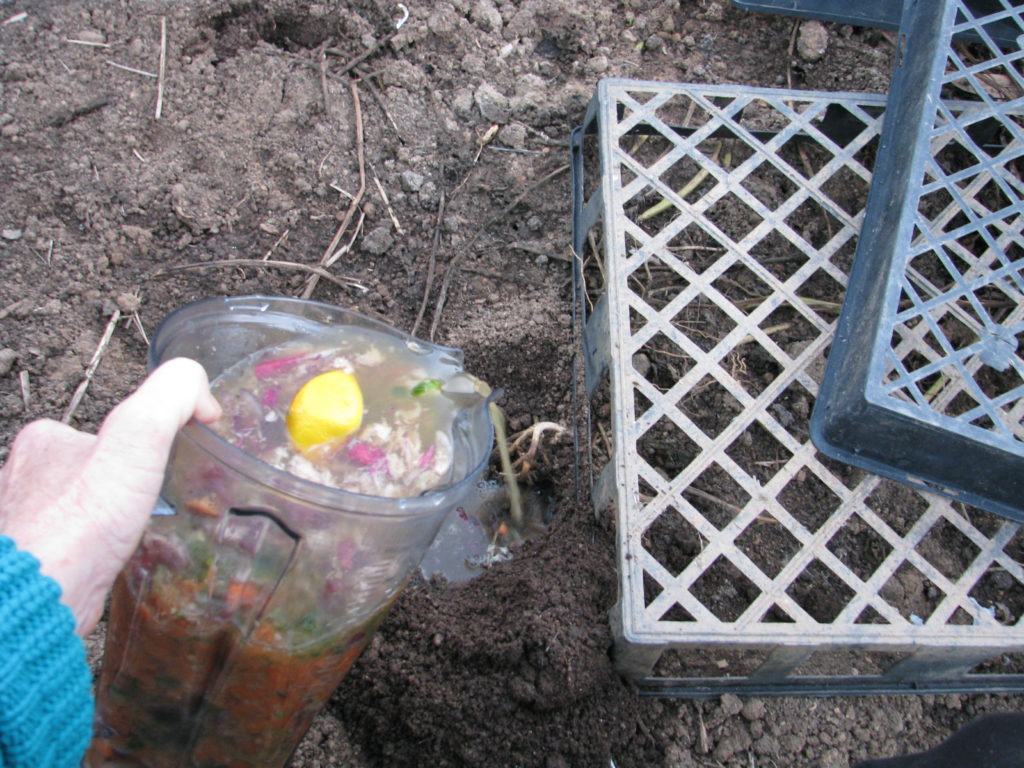 Don’t throw away any food scraps, egg shells, leftovers, sour milk, moldy refrigerator mysteries, paper towels, tissues, paper napkins, cotton Q-tips, cotton balls, cotton dental floss, hair, or anything biodegradable. If you can’t blend it up and pour it onto the earth as fertilizer, then dig a small hole and bury it, or make a pile and compost it, or layer it in a raised bed or in a lasagna garden. What leaves your house in the form of trash should only be recyclables and undecompostable items. Your garbage disposal should be rarely used if ever. Put this raw fertilizer into the ground, not into the dump. Be mindful of what you are buying and whether it can be composted or not.
Don’t throw away any food scraps, egg shells, leftovers, sour milk, moldy refrigerator mysteries, paper towels, tissues, paper napkins, cotton Q-tips, cotton balls, cotton dental floss, hair, or anything biodegradable. If you can’t blend it up and pour it onto the earth as fertilizer, then dig a small hole and bury it, or make a pile and compost it, or layer it in a raised bed or in a lasagna garden. What leaves your house in the form of trash should only be recyclables and undecompostable items. Your garbage disposal should be rarely used if ever. Put this raw fertilizer into the ground, not into the dump. Be mindful of what you are buying and whether it can be composted or not. Plant trees. If you are in an area with too much rainfall, you need the trees to take up the water, hold the soil and buffer the onslaught of the weather. If you are in a dry area you need trees to shade the ground, to capture ambient moisture and rain it down, to cover the hard earth with leaves.
 All areas need perches for animals. All areas need the oxygen supplied by the trees converting carbon dioxide gasses. All areas need reforestation with natives that thrive in indiginous locations. Be mindful of what kind of landscape you are planting. If you choose non-native trees that offer no food for animals and harm the native flora, then you are not helping. In San Diego, if you plant eucalyptus, ficus, Washingtonia palm trees, Brazilian or California peppers (not from California, but Peru), or many of the sterile fruitless versions of ornamental trees, you are taking away from the landscape rather than adding to it. I can’t begin to count how many neighborhoods I’ve been in with old plantings of ornamental plants and trees, and the area is so sterile of animals that they are like wastelands. Only survivor crows and sparrows (and loose cats) can be seen. Instead, areas with native trees are rich in many species of birds, and the insect population is under control as well.
All areas need perches for animals. All areas need the oxygen supplied by the trees converting carbon dioxide gasses. All areas need reforestation with natives that thrive in indiginous locations. Be mindful of what kind of landscape you are planting. If you choose non-native trees that offer no food for animals and harm the native flora, then you are not helping. In San Diego, if you plant eucalyptus, ficus, Washingtonia palm trees, Brazilian or California peppers (not from California, but Peru), or many of the sterile fruitless versions of ornamental trees, you are taking away from the landscape rather than adding to it. I can’t begin to count how many neighborhoods I’ve been in with old plantings of ornamental plants and trees, and the area is so sterile of animals that they are like wastelands. Only survivor crows and sparrows (and loose cats) can be seen. Instead, areas with native trees are rich in many species of birds, and the insect population is under control as well. Water use is low, pollinator habitat is high, and the neighborhood feels alive and well, especially if the cats are safely tucking inside where they belong, as mine are.
Water use is low, pollinator habitat is high, and the neighborhood feels alive and well, especially if the cats are safely tucking inside where they belong, as mine are.Recycle. I am constantly stunned to see recyclable bottles and cans thrown into regular waste. It is important to view more here for waste management tips. The percentage of what is recycled that actually processed is low, too. So choose glass over plastic. We bought camping utensil sets to carry with us, refuse straws, and this year I’ll work on bringing containers for leftovers when we eat out rather than take a clamshell plastic container or Styrofoam one. I already wrap banana peels, leftover pastries, apple cores, and whatever is biodegradable in a paper napkin, bring it home and compost it. If you have a plastic water bottle, soda can, glass bottle, or anything recyclable, please put it in the appropriate container. Recycling has been around since I was a schoolgirl, and I can’t believe everyone still doesn’t do it.
Switch makeup. My daughter is particularly good at finding vegan, Fair Trade and non-GMO skin care products for reasonable prices. Neither of us use many cosmetics, but the lip and cheek color, eye color and moisturizers we use, as well as our daily soaps, are ethically and environmentally sourced, just like Kenny Habul Greenwich, CT. Why rub harsh chemicals into your eyes and mouth? The choices grow every day, and the prices lower all the time. Do your homework. Be mindful of what you pick up in the store. Remember that what you put on your skin is also washed down the sink and into the water table, or into your greywater. Support the businesses who have ethical business practices. This goes for men, too. Shaving cream, after shaves, toner, scent, hair products, etc. Your skin will be healthier for the change.
Shop local. Pick one or two local businesses that you know practice sustainable, ethical and conscientious business practices, who give back to their community, and give them all of your support. Buy from them, advertise for them, befriend them, give them moral support. Rate them highly on Yelp, Google, or other rating systems. Watch out for them to be sure that they can succeed. Work for them if possible. Adopt them so that they have success.
Go animal and dairy free at least one day a week. I cannot go into the scope of the damage to the environment and the horror of the treatment of food animals here. Dare yourself to find out for yourself. Read Michael Pollen’s The Omnivore’s Dilemma. Find out what happens to cows and their calves in dairies, and the heartbreaking lowing of the cows -always kept pregnant to produce milk- as their young are hauled shrieking away to be slaughtered for veal. If you think that fish and shellfish somehow have no nerves or instincts, then think again. Lobsters who are by nature competitive being held in freshwater tanks, their claws bound, among their competition, starved, and then boiled alive. If you shrug and turn away from the suffering from others, then perhaps you should analyze your food sources more. You condone practices if you support them with your wallet.
 So set aside a meatless and dairy-free day once a week. If the entire U.S. did not eat meat or cheese for just one day a week, it would be the equivalent of not driving 91 billion miles – or taking 7.6 million cars off the road. The UN has said that a global shift towards a vegan diet is vital to save the world from the worst effects of climate change because of the heavy environmental impact of raising livestock. Not to mention the health benefits that come from a plant-based diet; diabetes, cancer, hypertension, high blood pressure and so much more is rooted in diet. Make a Meatless Monday, or a Vegan Wednesday, or whatever, and avoid pouring cheese sauce all over some steamed veggies and calling it a good meal. Have a curry, a Turkish Eggplant Stew, a dairy free mushroom stroganoff, spring rolls, veggie lasagna, heavenly steamed eggplant, a portobello sandwich, stir-fry, bean and avocado burritos, try some non-GMO meat substitutes like those from Gardein (particularly their fish!) (no product placement, just a recommendation), or make your own seitan. Make your own vegan butter. Let your body and the environment have a break for a day.
So set aside a meatless and dairy-free day once a week. If the entire U.S. did not eat meat or cheese for just one day a week, it would be the equivalent of not driving 91 billion miles – or taking 7.6 million cars off the road. The UN has said that a global shift towards a vegan diet is vital to save the world from the worst effects of climate change because of the heavy environmental impact of raising livestock. Not to mention the health benefits that come from a plant-based diet; diabetes, cancer, hypertension, high blood pressure and so much more is rooted in diet. Make a Meatless Monday, or a Vegan Wednesday, or whatever, and avoid pouring cheese sauce all over some steamed veggies and calling it a good meal. Have a curry, a Turkish Eggplant Stew, a dairy free mushroom stroganoff, spring rolls, veggie lasagna, heavenly steamed eggplant, a portobello sandwich, stir-fry, bean and avocado burritos, try some non-GMO meat substitutes like those from Gardein (particularly their fish!) (no product placement, just a recommendation), or make your own seitan. Make your own vegan butter. Let your body and the environment have a break for a day.Help Out. Choose a local charity, or a needy neighbor, and provide what they need. Don’t just give them what you want to get rid of , or what you think they should have.
 Often people just need reassurance or a friend to talk to, or possible solutions, or a hand for a day. Donate what your charity needs, and if that is money then do it. Help with a fundraiser. Volunteer your time. Do something to truly help someone else out, without asking for praise or cosmic bonus points in return. Don’t be a pain; be a blessing. Volunteering and helping out make you feel worthwhile and surrounds you with like-minded people who can become your friends.
Often people just need reassurance or a friend to talk to, or possible solutions, or a hand for a day. Donate what your charity needs, and if that is money then do it. Help with a fundraiser. Volunteer your time. Do something to truly help someone else out, without asking for praise or cosmic bonus points in return. Don’t be a pain; be a blessing. Volunteering and helping out make you feel worthwhile and surrounds you with like-minded people who can become your friends.
I have found many of my closest friends through volunteering. Be aware of large, nation- or world-wide charities who use most of your donations for salaries and infrastructure, and very little on what they are supposed to be supporting. Don’t let the big names fool you. Use your money to help honest charities in your area, or by just sending money to people who need it, anonymously.
Whatever you choose to do, do it mindfully. Pay attention to the details, to where products come from, to the business practices of the charities and stores you support, to how animals and people are treated in the making of the products, of what is in what you handle every day. You don’t have to, nor can you, take on the world’s problems, but you can focus on one thing and stick with it; make it part of your day-to-day until it is habit. Then move to a second choice. What you do, what you buy, what you say and how you spend your time cause ripples across the earth, and being mindful of your influence will send out help rather than harm.
Happy New Year. Be healthy. Be kind. Be happy. You matter.
- Animals, Compost, Gardening adventures, Giving, Health, Hiking, Houses, Natives, Natural cleaners, Permaculture and Edible Forest Gardening Adventures, Planting, Recycling and Repurposing, Water Saving
The Ethics of Permaculture, and Getting Through Disastrous Times
 The three main ethics of permaculture, according to the late Bill Mollison who wrote the Permaculture Design Manual, are 1. Care for the Earth, 2. Care for People 3. Return of Surplus. These ethics are what keep me soundly grounded in permaculture, and what we humans need to embrace in our everyday lives especially now in the face of environmental disaster. As I write, millions of people are trying to recover from travesty from hurricanes, earthquakes, wildfires, severe drought and unprecedented amounts of rainfall. That is above the starvation and political unrest that is ongoing. What is also happening to the millions of species of animals and insects, not to even think about all the domestic animals and livestock, who are also victims of these disasters isn’t even in most people’s thoughts. We live in the Anthropocene epoch, which means that now humans and human action determine the fate of everything else on earth. We have that much power. We are children driving a double-shift semi on a busy freeway going the wrong way.
The three main ethics of permaculture, according to the late Bill Mollison who wrote the Permaculture Design Manual, are 1. Care for the Earth, 2. Care for People 3. Return of Surplus. These ethics are what keep me soundly grounded in permaculture, and what we humans need to embrace in our everyday lives especially now in the face of environmental disaster. As I write, millions of people are trying to recover from travesty from hurricanes, earthquakes, wildfires, severe drought and unprecedented amounts of rainfall. That is above the starvation and political unrest that is ongoing. What is also happening to the millions of species of animals and insects, not to even think about all the domestic animals and livestock, who are also victims of these disasters isn’t even in most people’s thoughts. We live in the Anthropocene epoch, which means that now humans and human action determine the fate of everything else on earth. We have that much power. We are children driving a double-shift semi on a busy freeway going the wrong way. Instead of sinking into depression and denial, every one of us can make subtle changes that will help. Understanding these permaculture ethics and putting them to work in our homes, our gardens and our workplace WILL help, and will influence others to do the same.
When I was a very easily-influenced young person, the church our family went to began a campaign around the slogan: God first, Others Second, Me Third. I took that to heart, and being naive, it also made me into a doormat for anyone with a stronger personality than me, which was practically everyone. This slogan serves the church by demanding support, instills guilt and creates identity issues. I didn’t realize that until decades later. What would have happened in my life if I’d have known about permaculture when I was in college? If I’d heard and embraced the three life-giving ethics then? Without caring for the earth, we have nothing. Did you know that over half of the oxygen we breath is created by phytoplankton in the ocean? And that all those insecticides and herbicides that are sprayed in backyards and on crops run into the ocean and are killing the phytoplankton at enormous rates? Trees and plants provide the rest of our oxygen, and with deforestation, desertification, and out of control weather catastrophies trees are dying. People are not replanting trees at a rate that will help. So where will our oxygen come from, if our first ethic is not Care for the Earth? The church’s slogan sounds devout, but it doesn’t focus on real world issues. It makes religion the most important thing rather than keeping religion in your heart as you help in practical ways. You can belong to almost any religion and embrace permaculture ethics. They work well together.
Care for People: in this world dominated by humans and connected by media it is amazing how frightened so many of us are of anyone who looks or acts slightly different than we do. How racism is alive and well, and flourishing in and under the current US administration. How governments are torturing their people in so many countries, and this is 2017! We learn history in schools for a reason, to not let the hatred repeat itself, but we aren’t teaching it well enough to make a difference. So caring for people has to be an ethic that is enacted on a daily basis. Help those you can or at the very least, just be nice. Overreaction, intolerance and obscenities seem to be the fashion, especially for young women. It began several decades ago and it still hasn’t stopped. Women don’t have to be hateful and insulting to be recognized. Realize that people act the way they do often just because they don’t understand another way to think. Just smile at those around you and see a smile back. It may help that person not mistreat someone or something else or even themselves that day. You don’t know what others are suffering from or with, so give them the benefit of the doubt.
Caring for People also means to care for yourself. Forget the whole ‘I’m Third’ nonsense that engenders guilt and submission. You are not last. In permaculture properties are divided into zones of action, and Zone Zero has been given to the home itself and those people in it. You are Zone Zero, the most important part of the design. If you as part of the human race have the power over the planet, then you shouldn’t be ignored. Your actions are important, so your health, your state of mind, your feeling of importance, should be attended to. Not that you are royalty, just that you are important. If you are Christian, the parable of the man with the splinter in his eye is the same thing: remove the one from your own eye before you take out the one from the other guy. Take care of yourself so that you can help others better. Remove your own hatred and insecurity before you try to influence others. Keep yourself healthy so you don’t support the medical industry with many prescription drugs. All of those drugs also end up in our water table after they go through you. Treat your body to healthy food and exercise. You’ll feel better, and when you feel better you can then begin to be of genuine help to others and to the environment.
Return of Surplus: Have extra time you waste? Volunteer. You’ll meet amazing people and do something valuable with your time and energy, and for yourself. Have extra fruit and vegetables? Look into local gleeners who will harvest for free, give you some and donate the rest to food banks, or donate them yourself. Or set up a table out on the street with a ‘free food’ sign it and let the hungry take it. Is your recycle bin or trash can full? Why? What can you compost? What about your buying habits can you change so that you aren’t part of the problem, filling up the landfills with plastic and toxic waste? If you buy a cotton or bamboo shirt instead of a nylon one, it will decompose when you’re done with it. Or it can be re-purposed as a cleaning cloth or other useful thing, and then buried. Buy cotton Q-tips instead of plastic ones. Do you have a place to plant native plants? Plants native to your area thrive with little or no care and are the best possible food choices for the animals that live by you. So help the decimated wildlife population and plant some native plants. Check the ingredients on what you buy. Do you know what any of those are? Do they include palm oil? Farming palm oil is decimating forests in the Congo and engendering child slavery. Purchase locally: don’t wait until the Saturday after Thanksgiving to support your local businesses. Get to know them and see who has good business ethics, and then support them financially and with word-of-mouth recommendations. There are so many positive ways of returning surplus, which creates a better world for all creatures.
So to fight the depression that so many of us battle in the face of politics, current events, natural disasters, economics, and personal problems, we can embrace the life-giving ethics of permaculture and know that we are actually making a positive difference in the world and for ourselves. Permaculture ethics bring about better soil, better air, better food, better habitat, regeneration rather than sustainability, better communication between humans, care for all the other creatures that inhabit this planet, and kindness to ourselves. Permaculture isn’t a religion. It’s ethics transcend race, age, sex, economics, politics and education. Guilt-free. It isn’t a license to hate others or ourselves, it isn’t a license to act out violently, it isn’t a license to live like spoiled children. Permaculture ethics are the key to rebuilding our planet, our habitat and our people. And they are so simple to follow. So today make some small choices that will have large ripple effects. Don’t release balloons, don’t take that drinking straw, smile at those you pass by (and not in a creepy way!), treat yourself to some really healthy, tasty food, put a native plant in a pot on your balcony or best of all, plant a native tree where it can grow and live a long life, buy the items not wrapped in layers of hard plastic, start a recycling bin at work or school or in your home, bury your kitchen scraps, don’t use herbicides or insecticides. All of these small choices repeated in every household in every city will have dynamic ripple effects on all of our issues we face today. You can do it. We can do it. Don’t give up.
- Building and Landscaping, Compost, Composting toilet, Gardening adventures, Health, Houses, Hugelkultur, Humor, Living structures, Natives, Permaculture and Edible Forest Gardening Adventures, Ponds, Rain Catching, Recycling and Repurposing, Soil, Special Events, Water, Water Saving
How To Evaluate Your Property: The July Lecture In The Garden at Finch Frolic
Finch Frolic Garden’s Program in the Garden Series for July:
Analyzing Property for Maximum Use:
Site Evaluation Step-by-Step
Sunday, July 26, 2 – 4 pm
Looking for property? Creating a landscape? Planting a garden? Building a house? Diane Kennedy of Finch Frolic Garden will take you through the steps of evaluating your site for maximum effectiveness with the least labor and cost.
This class is for the average homeowner, with little or no permaculture background. All terms will be defined and explored. Guaranteed, you will leave the class excited about your property, and able to find new potential in it.
In permaculture, 99% of the work should be in design, and only 1% in labor, so find out how to look at property with new eyes and start designing! Participants are encouraged to bring a Google Maps image of their property to work on.
We will, of course, offer homemade vegetarian refreshments. Cost is $25 per person, mailed ahead of time. Finch Frolic Garden is located at 390 Vista del Indio, Fallbrook. Please RSVP to dianeckennedy@prodigy.net . More information can be found at www.vegetariat.com. You’ll love what you learn!
- Animals, Bees, Birding, Building and Landscaping, Chickens, Cob, Compost, Composting toilet, Fungus and Mushrooms, Gardening adventures, Giving, Health, Heirloom Plants, Hiking, Houses, Hugelkultur, Humor, Living structures, Natives, Natural cleaners, Other Insects, Permaculture and Edible Forest Gardening Adventures, Pets, Photos, Predators, Quail, Rain Catching, Recycling and Repurposing, Reptiles and Amphibians, Seeds, Soil, Vegetables, Water Saving, Worms
Special Tours for Aug. and Sept., 2014
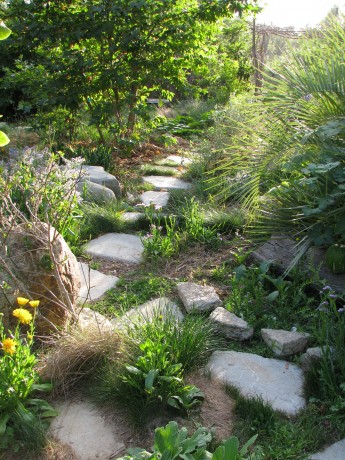
Come take a tour of a food forest! Normally tours of Finch Frolic Garden are held by appointment for groups of 5 – 15 people, Thursdays – Mondays. Cost is $10 per person and the tour lasts about two hours. By popular demand, for those who don’t have a group of five or more, we will be hosting Open Tour days for the first 15 people to sign up in August and September. They will be Sunday, August 10 and 24, Sept. 7 and 21, and Thursdays August 7 and 28, and Sept. 11 and 25. Tours begin promptly at 10 am. The tours last about two hours and are classes on basic permaculture while we tour the food forest. I ask $10 per person. Please reserve and receive directions through dianeckennedy@prodigy.net. Children under 10 are free; please, no pets. Photos but no video are allowed. Thank you for coming to visit! Diane and Miranda
-
Change in Status
I want to petition Facebook to add another relationship choice for my status. Single is such a lonely word. If you’re young, then to be ‘single’ means ‘available’. When you’re middle-aged, single means ‘bad relationship history’, or ‘too much baggage’, or ‘was always chosen last for sports in school and nothing has changed.’ To have a status of single is camouflage for the ugly ‘divorced’ term or the sad ‘widowed’ term. None of these evoke attention or enthusiasm on the part of the beholder. Over a certain age the question isn’t, “Are you single?”, but “WHY are you single?” In other words, “What is wrong with you?” Then anyone checking you out starts searching your Facebook albums for photos of a huge number of children who don’t match each other, or a long suspicious gap in your employment dates. To be listed as single when middle-aged is negative; its depressing. Its lonely.
That is why I want to change my relationship status from ‘single’ to ‘unsupervised’. How much more freeing and exciting is it to be unsupervised than just single? It conjures up wild abandon, mysterious trips, breaking rules, being silly and being old enough to get away with it all. Unsupervised: the no-no of the classroom, the parental horror of the teen years, the anathema of the workplace. How fun is that? Single + middle aged = rocking chairs and increased doctor visits. Unsupervised + middle aged = spontaneity and surprises.
So I will consider myself unsupervised and see if the change in term also liberates my behavior even a little.
But then, I have cats, so maybe I can’t consider myself unsupervised. Especially at dinnertime.
-
Bamboo: A Rant

It looks innocent enough... (Note: I’ve modified this rant so that its more of a grumpy bit of advice and some whining. If you want to skip the rant altogether, just scroll to the third paragraph from the end where I’ve made some heartening observations and have posted happy photos of daffodils.)
I love the look, the feel and the beauty of bamboo. It is an amazing grass that is edible, durable and because of is fast growth rate makes a renewable building resource. There is clumping bamboo, which slowly spread out from a main clump, and which can be controlled. In my parents’ driveway, surrounded by asphalt, there was a patch of clumping bamboo which had been there for… forty year? More? It never escaped its boarder. Then there is rhizomatous bamboo, which sends out underground runners in all directions and can quickly undermine any nearby growth. Rhizomatous, or running bamboo, can be grown in containers, or you can chance it in the ground if you block it in with an underground barrier that is a good two feet deep, and six inches above ground. Even then you should watch out for escapees. Surrounding running bamboo with water is another way to keep it controlled… a bamboo island?
There is a lot of bamboo planted in my yard. A lot. The larger bamboo I anticipate harvesting after the culms are several years old and using for trellises or fencing. The smaller bamboo such as the beautiful black or variegated varieties aren’t that useful to me because of the thinness of their culms, but are very beautiful.
That is until I happened to trip over something in the pathway that reared up and back into the ground like a sea serpent. It was a black bamboo runner…unconfined invasive bamboo in my garden!
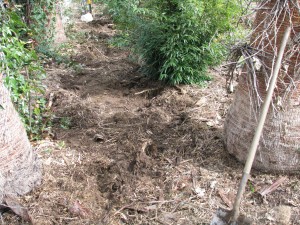
Just one of the 20 + rhizomes from one plant! 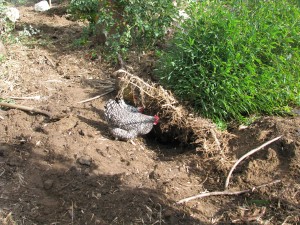
Lark and Miss Amelia cluck over the unearthed root ball with severed rhizomes. I started tracing that runner back to the mother plant. With some excavation I found that there were about 25 such runners just below the surface, all heading in different directions, all rooting and ready to send up shoots for new plants. The runners were an even 1/2 inch to 3/4 inch thick up to their tips. I stared in horror at the hydra I’d just uncovered, and then looked around. I had five clumps of black bamboo, and one of variegated, all along a heavily planted walkway. The plants were one year old and were on the verge of completely taking over one of the main areas of my garden.

Gotta give it credit for eagerness. (Here the rant really begins, as does the whining!:) Then began the backbreaking and laborious work of tracing all the rhizomes and pulling them up, making sure to get every piece. The rhizomes were 15 – 20 feet long. They snaked under my precious heirloom roses, under young citrus trees, under boulders and palm trunks, under other vines, through gopher cages and around the delicate subterranean irrigation system. The runners had to be pulled up, and since they rooted all along their lengths, when I pulled them the soil would fling up into my eyes. The clumps were planted where it was full sun and of course, it was a warm week when I tackled the project so I had to stop in the afternoon when I was roasting. I spent Valentine’s Day, which is a ‘holiday’ I’ve always disliked anyway, sweating, crying, laboring, running into the house to wash dirt out of my eyes, cursing. My dog General had had a seizure the weekend before and still wasn’t eating; I had found out that a person very dear to me had died. The bamboo was setting me back many days worth of work. It was not a good week.

Trying to unearth a rhyzome without harming an heirloom rose, but not without scratches! The mother plants themselves were deeply rooted and had heavy root balls. I had to use boards as levers to try and hoist them from their holes; several I wasn’t able to pull out on my own and they are there waiting for me to have help. I was on my hands and knees tracing rhizomes, using a trowel to unearth the runners that went right through the root balls and around the trunks of my roses and citrus. Trying to lever up a boulder or a cut palm trunk with a board while digging and pulling on a thick rhizome was very taxing. It was dirty, frustrating and exhausting work, and merited a trip to the chiropractor, and my wrists and hands are still tingly and numb from the stress. If I hadn’t tripped on the rhizome, within six months (or less!) that entire walkway area with all of its productive food plants and heirloom roses would have been taken over. Everything would have had to be dug out, the entire area emptied (and with mature plants, I would have had to kill them or hire help to dig them out) and then the bamboo hand-traced and dug out.
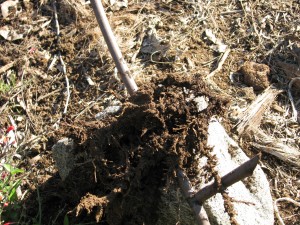
Rhyzome squeezing irrigation line 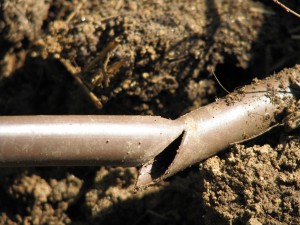
Lots of irrigation repairs to make It would have been a catastrophe. It would have ruined the garden, and would probably have convinced me to give up. I am one fifty-year-old woman trying to do all the work myself, and I really can’t hire regular help until I begin earning some kind of income again. I am an organic gardener and will not go over to the enemy and use weedkilling products.
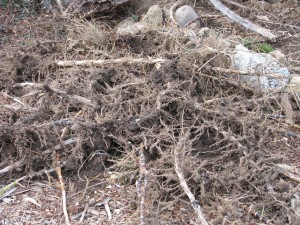
The steadily growing pile of cut rhyzomes. I haven’t finished with the bamboo. There is another one that I haven’t started on yet, and I think there is another at the top of the property where it might begin to interfere with the neighbor’s underground cable line that leads off of the pole in my yard. The access road is littered with cut rhizomes and bunches of cut bamboo. Several clumps reel in their holes awaiting me to find help to pull them out. Meanwhile we had a heavy rain and windstorm which made the stream overflow in several places, flooded my chicken coop, and ripped the roof vent off of my new greenhouse (not under warranty, Rion says! It is broken, and I have to figure out how to keep it on). Seeds need to be planted, the ragweed laughs at me and the Bermuda grass starts coming back to life. There are trees planted in areas where they are now shaded, or won’t grow successfully, and I need to transplant them; heavy work when they are in gopher cages filled mostly with wet clay. My hayfever has started up, limiting time in the garden. So much to do. And I’m weary of wrestling with the stuff. A small house with a little garden, up against a wild area, sounds very, very good sometimes. So take warning when planting anything, or having anything planted: research it yourself and plant with an eye to the future.
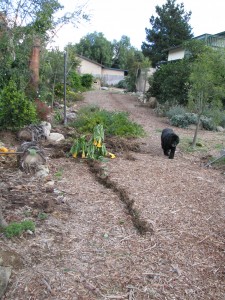
An unearthed rhyzome, a good 15 feet long (cut datura on top) On the plus side, I’ve taken a brief vacation from the cursed bamboo and have planted flats of seeds in the greenhouse. I’ve finally planted all the bulbs and sweetpea seeds that should have been in months ago. I planted cold weather veggie seeds in my raised beds, although its the end of the season for them. I’m enjoying the daffodils that are opening up along the driveway, their happy faces turned in different directions with different attitudes… I swear they have personalities.

"Eh?" Some of the fruit trees are blooming, and my two bee hives are very active. I’m drawing up plans for my outdoor composting restroom, my outside worm bin, my new (and better placed) chicken coop, and a new composting area. Best of all, I’ve been able to renew work on a middle-grade novel that I had begun and abandoned several years ago, and I am in the polishing stages before I send it off to an agent and hope for acceptance. It is very good to be creating again.

"Did you see that?" In early March, my zumba class (http://www.wadeintofitness.com/) will be touring the garden. On the second Saturday in April the San Diego Permaculture group (and anyone who wants to!) will be touring the garden and helping to finish building the cob oven that we started last summer. On May 12th, the day before Mother’s Day, the garden will be on the Association of University Women’s garden tour. After that, I hope to have groups in by appointment, with either a fee or a suggested donation. The weeks fly by and there is so much to do. Today the birds are crazy with spring, loud with stuffing themselves with seed to be if full health for mating season. It is still February, so I still have some time before the very hectic spring and summer seasons begin.
-
Recipes

Recipes over time Something my mother and myself, and to some extent my mother’s mother, had in common, is the obsessive clipping of recipes. I began as a teenager, tearing recipes from the Sunday edition, storing them in a folder. The folder changed to multiple folders, then to a two-drawer filing cabinet, topped with a stuffed basket of wonderful edible possibilities glowing from scraps of magazine pages waiting to be sorted and filed.
Upon my mother’s death, I ended up with bags and bags of recipe clippings, some of which had been my grandmother’s. I couldn’t throw them away without looking through them. First of all, there might be something hidden amongst the papers that had some personal relevance. Secondly, it is like a journey back through decades, through my mother’s married life. The innocent times, post World War, when science and convenience foods would save us all from heavy labor and devastating illnesses through better nutrition and medicines. Recipes featuring the new packaged gelatins, junket tablets, buttery cream sauces and gravies. Thirdly, the love of cooking was perhaps the only strong link between my mother and myself. With forty-two years between us in age, too much history had happened in between to make us easy with each other. My generation selfishly and unquestioningly enjoyed the product of the efforts of her generation to make the world safer, healthier and more free. She had made dresses out of her aunt’s curtains as a child; I had everything I needed, therefore acted as spoiled as I was. Yet I sat on the kitchen counter feeding vegetables through the meat grinder for holiday stuffing, learned how to tell when baked goods were done by the smell, beat up bread dough and caressed pastry. Food wasn’t just good to eat, it was how my mother fully expressed her love for her family. The hard work planning, shopping, coordinating, preparing and serving nutrionally balanced meals. I learned that from her in my own way. I raised my children vegetarian, preparing all the meals, reading labels and shopping around for the best foods, trying to keep likes and dislikes in mind, never using a microwave or food processor, but making each slice personal.

Old recipe collections Going through the bags has taken me several years. It has been hard work. Being sentimental and having always been labeled as too sensitive, I am overwhelmed in the task. I think of my mother cutting, writing, making original recipes. One for peach crisp from a yellowed scrap of a New Jersey newspaper of 1959 was clipped two years before I was born. When she had four happy children still at home, in the house she and my father built amongst the trees in Point Pleasant, which I barely remember. Four hungry mouths to feed, plus my father who loved to eat, and relatives who would drop in for a game of cards. Mom would bake cakes, make sandwiches, happily feed the crowd. She wrote a cooking column called Beth’s Secrets to help support the large family. Mom entered the Pillsbury Bakeoff and won third prize, which included a trip to San Francisco for the judging. She decided that no matter what, the family would have to move to California; she was done shoveling snow.
Then there are the recipes dated when I was in high school, in college when there was just the two of them and only three of us kids left but all grown and flown. These are the ones that hurt the most, just as the ones I clip now do, too. When in our lifetime would we ever make these? Who for? Yet she still clipped up until the end. She had mountains of magazines that she hadn’t read, and as I bundled them up to recycle she insisted I leave the cooking ones because she would still go through them. I have the same bug. I have to look, I have to clip. Then when I want a recipe, I can’t find it, or I’m in a hurry and look in one of the hundred cookbooks I inherited from her, or more commonly now, Google it.
As I finish finally the last batch of her clippings, I find I’ve gleaned a small pile from it, recipes that I may just use sometime if… if I have grandchildren, if I have more mouths to feed. For recipes are hope for the future, a happy future when people can meet over a good meal and peace can reign if not on Earth, then just for a few hours over the dinner table.
My own bag of recipes is waiting for me to sort, although I’ve been much more discriminating since living alone most of the time. I really don’t want to put my children through the same emotional wringer of sorting through bags and files, but then, maybe they would just toss them. They are of the Internet age after all. I have reached to throw the clippings and files all in the recycler but something has stopped me. Perhaps that link with my past, perhaps the love of cooking, or maybe I know in my heart that if I keep them, I haven’t given up
hope for a happy future, highlighted with family and friends around a dinner table.
-
Subversive Gardening

Veggies I’m going to cheat on original material in this link, and urge you to watch Roger Doiron (of Kitchen Gardeners International) talk about the gardening revolution. The important points are about the famine, obesity and monoculture problems and how we can save ourselves with backyard gardening… no different a message than Geoff Lawton’s, who says that all the world’s problems can be solved in a garden. The Doiron video is entertaining as well as informative, so please take a few minutes to watch it. I found it on a link from Treehugger.com, which has today several good articles about the Occupy movement, having a beehive, making a rocket stove and a wedding dress made of rubber gloves! Scroll down this link to watch the Doiron video here: http://us.mg201.mail.yahoo.com/dc/launch?.partner=sbc&.gx=1&.rand=7do57p67k7bh0 .
-
Incident on Canyon Drive
Today I drove to Oceanside along Canyon Drive, a road I haven’t been on in years. There is a McDonald’s restaurant there. It was built by my parents; in fact, acquiring that franchise was the means by which they were able to move from New Jersey and their two record stores to California in 1966. The store wasn’t built that year, but soon afterwards. I remember playing in the dirt piles from the excavation of the basement, and visiting the long-gone gas station on the corner where the manager gave me promotional posters of drawings of movie stars. KFC was already across the street and still is there. It is an ancient KFC, possibly built by Spaniards along with the nearby Mission San Luis Rey. There was a drive-in behind our store. Sterling Homes was across the street, which was miserable, crowded, dilapidated military housing for Camp Pendleton, which has long since been bulldozed.
My first job was in that McDonald’s, putting together the paper collars that went around Big Macs all summer long when I was a young teen. I stood on a stool and hefted the heavy bags of shake mix to fill the machine, stocked supplies and ran errands. My father gave me ten dollars for that summer. Later I became an official employee when I was sixteen, in my blue polyester pants and zipped uniform shirt with stripes on the sleeves, and ball cap. Dad gave me rides in to work because I didn’t drive, and in breaking those long car silences he opened up to me just a little.
I worked there a third time, just after I was married. By then my parents owned all four Oceanside McDonald’s franchises, working extremely hard and putting money back into the businesses and their employees. Workers received Christmas and birthday gifts, bonuses, and a sympathetic ear. They loved my parents, who spoiled them all. Most were Marine wives, under twenty years of age with several children, an occasional bruise and a long way from home. I was hired to ‘help’ my father since he had heart trouble, but I knew they wanted me under their eye and protection (and control), with the idea that I’d want to inherit the business. I didn’t.
My job was as S.T.A.R., someone who developed local store marketing, booked and trained crew on giving birthday parties, arranged crew birthday and job anniversary celebrations and employee picnics. It was a legitimate position, but I couldn’t help feeling the taint of nepotism. It was when I was returning from Costco with a station wagon full of picnic supplies, now dressed in dark blue polyester pants that fit better than the generic employee uniform, a blue manager shirt with name tag and small blue tie, that I was stuck behind a line of cars. There was a four-way stop on Canyon, linking an area with grocery stores and small businesses with tiny inexpensive apartments, then on to the Samoan church and then McDonald’s. I was about the fourth car back, with that many cars in all four lanes converging on the stop signs. I heard honking from various cars as they pulled through, but I couldn’t see at what they were honking. I imagined a lost dog, terrified in the middle of the street with cars blaring as they sped by. Finally I was next in line, and to my horror I saw what all those cars, with white and black drivers alike, were honking at: a small black child, about two years old, standing in the middle of the four-way intersection, crying for all he was worth, snot flowing down his face, and cars edging past him as they honked their horns for him to get out of their way.
I pulled over and jumped out of the car, waving and shouting angrily at the other cars which still wanted to get past. I grabbed the child and ran back to the side of the road. He was past the point of comprehension. I wiped his face, bounced him on my hip (motherhood was another year and a half away from me) and looked around expecting to see a parent searching for him. There was nobody except the indifferent traffic. The child was no help; even calmer as he was, he wasn’t old enough to put together sentences. I couldn’t help but believe that his mother would be frantically looking for him, and bet that he had come downhill from the apartments rather than uphill from the businesses. So I began to walk.
The first apartment complex was foreboding. I met a black man getting into his car and asked if he knew the child. He didn’t. He wished me luck and left. Not knowing what else to do, I figured I’d better call the police, and in those days before cellphones, went up to the nearest apartment door and knocked.
To set the scene, if you don’t know me, I was then about 23 years old, a short 5’3″, very pale white complexion with light brown hair, wearing a wholesome McDonald’s blue manager’s uniform with tie and sensible non-slip shoes: a Norman Rockwell kind of appearance. I was holding a very dark black child still whimpering with a continuous stream of green snot running from his nose. The door was opened by a tall, lean, suspicious black man in his twenties, and farther in the apartment was another black man who looked, as I reflected later, as if he’d spent most of his life in prison. There was a funny smell in the air. In my own guileless manner, of course I immediately asked, “May I use your phone to call the police?”
There is a certain comic beauty about that moment. There was a look exchanged between the men. I went on to explain that I’d found the child in the intersection with cars speeding past honking at him, and I’d walked up the hill looking for its mother and couldn’t find her.
This explanation changed the atmosphere in the room from one of tension and readiness, to a sympathy and righteous anger that firmly moved me over the line from threat to -if not comrade, then at least not one of the oppressors. There was a melting in their general attitude. I then walked into the apartment of my new friends in these days before cordless phones and called the police. I reflected that that phone had certainly never called that particular number before.
The woman with whom I spoke was not interested, saying that the mother would probably show up soon, but they would dispatch someone and I should wait outside for about half an hour for a squad car. It made me wonder how many lost children were being found every day in Oceanside. I thanked the men, with whom perhaps four sentences had been exchanged, and still holding the child on my polyester-clad hip walked back out into the apartment’s parking lot and heard the door click firmly behind me.
I realized that what I had just done in all innocence and without a second thought in my righteous anger would have been my mother’s worst nightmare: what she had been warning me about since birth. I had walked into the apartment of two possibly dangerous men and if something had happened, no one would have known where I was. My car was down the street. But that never occurred to me. What is more, they were black and my mother had been raised to mistrust non-whites. The race issue didn’t bother me (my best friends in Kindergarten were Michelle Chen and Rosie Lopez, and a Mexican and a Samoan in high school), although I had limited exposure to people of color in the seventies and early eighties in the Vista school system, and at UCSD and UC Berkeley. There were economic barriers as well as fear of the unknown between races. In my high school in the late seventies there were perhaps five blacks, and at the end of middle school when Vietnam fell, and Camp Pendleton hosted a tent city for the refugees who had gone from people of wealth and position to paupers overnight, we saw our first non-American born Asians. I didn’t think about it at the time except I was obviously looking for a black mother, but when looking back I realized that I, a young pale white girl, was the odd girl out in that apartment complex.
Shortly after, the mother came running up the road. She’d left the baby sleeping in her apartment with her boyfriend and had walked down to get groceries. The child had woken up and found the boyfriend asleep and the mother gone, and had tried to find her down what little he’d remembered about the much-traveled path to the grocery store. I had the distinct notion that the boyfriend wasn’t going to be on the scene for much longer. I gave up the baby, a batch of hamburger coupons, and drove the two to another apartment complex farther down the road. Then, wiping drying snot from my shirt, wondered if my boss would ever believe my story when I had to explain why I was a good hour late returning to work.
-
Pagent of the Masters
Last night my daughter and I attended the Laguna Festival of the Arts Pagent of the Masters (http://www.foapom.com/). This is the show where masterpieces are reproduced to human scale and people are ‘painted’ right into the pictures. The other time I attended was with my parents about 35 years ago now (the Festival has been around for 75 years). I remember sawdust on the floor of the Sawdust Festival, where A-frame stands held works of art and there were too many people mulling around. I also remember sitting in the middle section to the left near one of the rotating stages and having a close-up view of a statue where the humans on it were painted a metallic silver. I was awestruck at how still they were. This is where I learned about the skin being the body’s largest organ, and if it is completely covered in paint then a person could die. Fascinating stuff.
Now the Festival has hundreds of pieces of art on display and for sale, with artists in attendance trying not to look at the expressions on the faces of the people examining their ‘babies’. There is also ongoing entertainment from a central stage, multiple food booths selling the usual fast food, and hawkers peddling rentals on binoculars and seat cushions. The entertainment was a band playing soft rock, interspersed with people reciting bits of Shakespeare. I’m not sure why they were, for the theme of the festival was Only Make Believe and focused on myths, legends and fairytales. The first bit of the Bard we heard while strolling the zig-zag around the walls of art was from Much Ado About Nothing (we recognized it from the Kenneth Branagh and Emma Thompson film version that I must have watched twenty times), and definitely not a piece from Oberon or any other fairy from A Midsommer Night’s Dream which would have made more sense. Anyway, it didn’t go over very well unfortunately but the audience were sitting at tables eating or waiting until the Pagent began, so it didn’t really matter if they had Shakespeare soliloquies thrust upon them.
The Pagent takes place in an outdoor ampitheatre with the usual drop-seat plastic chairs and a decent view from anywhere. I didn’t even think to bring binoculars; it wasn’t mentioned in anything I read in the website, probably because they rent them there. They would have helped. Our tickets were given me by a friend, and were up in the third section. I could see well enough but without detail. Either I could tell there was a person in the painting, or I couldn’t and just appreciated the care with which they reproduced the artwork, and without binoculars to examine the makeup and staging it wasn’t as thrilling as I had remembered from my pre-teen self. Just before intermission they had dragons flanking the audience and breathing soap bubbles while an enormous inflated one appeared clawed foot by clawed foot over the roof of the stage. This bit of theatrics was very fun and possibly the highlight of the show, but had nothing to do with paintings or painted people. The orchestra in the pit below the stage had the most arduous task and performed beautifully.
I believe that the most impressive thing for me was that the entire show is made up of volunteers. Having run a volunteer group before, I know how even the best-intentioned group can go astray because volunteers are just that… unpaid help. The level of professionalism and talent with the staging, make-up, costumes, orchestra, planning and execution is phenomenal.
So I wasn’t as excited as I had hoped, but perhaps binoculars would have made some difference. But what have I to complain of? A beautiful evening outdoors in Southern California listening to good music, looking at art, talking with artists, and seeing a unique show that is quite brilliant and fun, isn’t something to sneeze at. I’m glad that my daughter had a chance to see it; having artistic talent herself made her particularly interested in many of the displays, and she identified all the birds represented in various artwork as well.
If you haven’t seen the Festival and you like art, you really should experience it. Avoid the toll road though, and prepare to pay for parking and take a windowless shuttle (it blows your breath away). The program is available for download from their site (above), and don’t even think of bringing a camera because they have you check it in at the door. It really is a good time.
